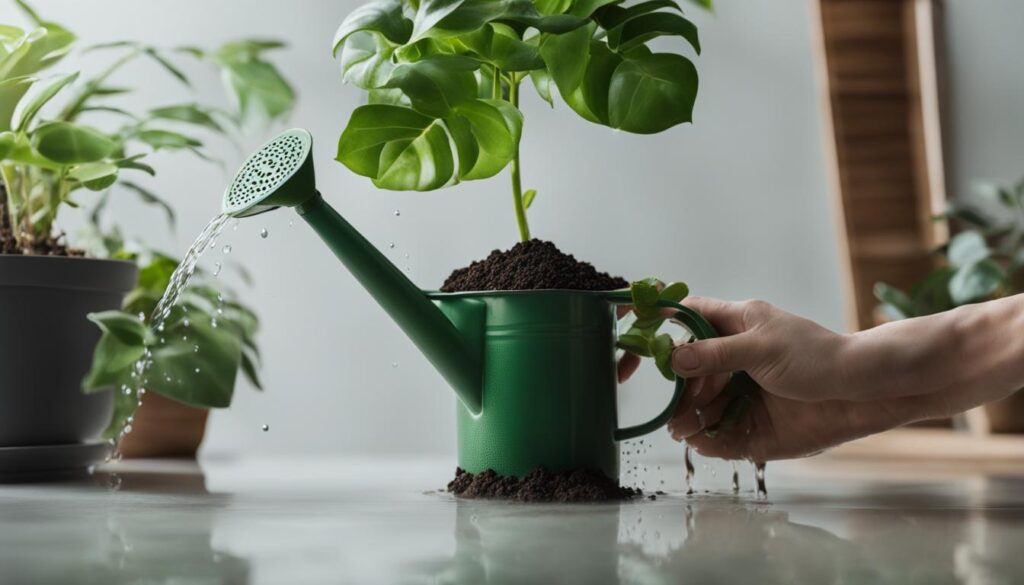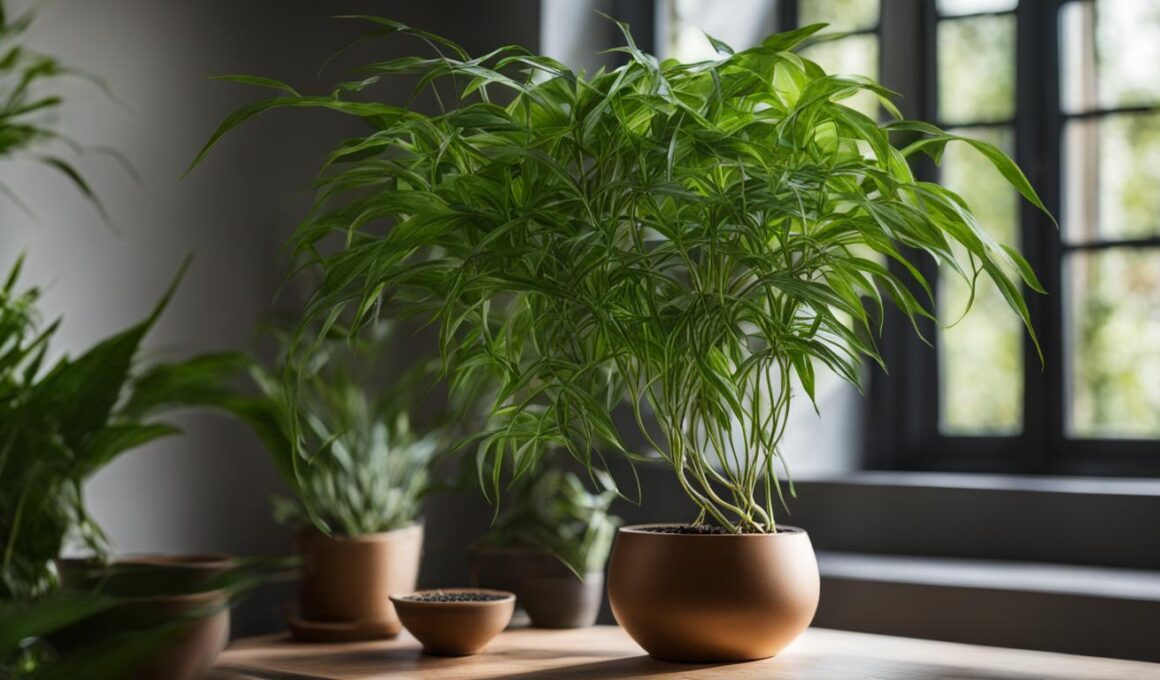If you have a leaning houseplant, you’re not alone. Many potted plants tend to lean over time, but luckily, there are simple solutions to fix this issue. One of the main causes of a leaning houseplant is insufficient sunlight. When a plant only receives sunlight from one direction, it tends to lean towards that light source. In this section, we will explore how to address this issue through rotation and ensuring adequate sunlight.
Post Summary:- Insufficient sunlight is a common cause of a leaning houseplant.
- Rotate the potted plant every week by 90 degrees to ensure even sunlight distribution.
- Address top-heaviness by pruning leaves and branches to restore balance.
- Use a stake to provide immediate support until the underlying issue is resolved.
- Proper sunlight and care will result in a healthy, upright houseplant.
Protecting Your Leaning Houseplant with a Stake
When dealing with a leaning potted plant, using a stake can provide temporary support and prevent it from falling over. To do this, find a long, narrow, and sturdy stick, such as a bamboo stick or plastic stake. Push the stake deep into the potting soil, away from the roots. Straighten the plant and tie it loosely to the stake using twine or garden ties, ensuring that the stake does not harm the stem. This method is effective for both indoor and outdoor potted plants.
By providing support with a stake, you give your leaning houseplant the stability it needs while addressing the underlying issues. The stake acts as a crutch, keeping the plant upright and preventing further leaning or tilting. It allows the plant to continue growing and thriving without the risk of toppling over.
Utilizing a stake to support your houseplant is a simple yet effective solution. The process involves minimal effort and resources but yields significant results. Not only does it offer immediate support to the leaning plant, but it also gives you time to address the root causes of the issue, such as insufficient sunlight or top-heaviness.
| Benefits of Using a Stake: |
|---|
| Prevents falling or leaning over |
| Allows the plant to straighten and grow upright |
| Provides temporary support while addressing underlying issues |
| Suitable for both indoor and outdoor potted plants |
Important Tips for Using a Stake:
- Choose a stake that is long, narrow, and sturdy
- Position the stake deep into the potting soil, away from the roots
- Tie the plant loosely to the stake using twine or garden ties
- Ensure the stake does not harm or damage the stem of the plant
Remember, using a stake is a temporary solution to support your leaning houseplant. It is crucial to address the root causes of the issue, such as insufficient sunlight or top-heaviness, to promote long-term plant health and stability.

Protecting your leaning houseplant with a stake is a practical and effective way to prevent further tilting or falling. By providing immediate support, you give your plant the stability it needs while addressing the underlying issues. With the proper stake and secure tying, your houseplant can resume its growth and thrive in an upright position.
Addressing Insufficient Sunlight for Your Houseplant
Insufficient sunlight can be a common issue for indoor and outdoor houseplants, leading to leaning and uneven growth. To ensure your plant receives adequate light, consider the following strategies:
1. Find the Right Location
For indoor plants, it’s essential to place them in a location that receives good sunlight on all sides. Observe the light patterns in your home and identify a spot where your plant will receive the most balanced amount of light throughout the day.
2. Rotate Regularly
Rotating your houseplant can help ensure that all sides receive equal light exposure. After watering your plant, rotate it by 45 degrees to distribute light to different areas. Repeat this rotation each time you water to promote even growth.
3. Consider Supplementary Light Sources
If your home or office lacks sufficient natural light, you can supplement it with artificial light sources. LED grow lights are ideal for providing the necessary light spectrum for plant growth. Place the lights above your plant, ensuring they are at an appropriate distance and set them to a timer for consistent light exposure.
Finding the right balance of sunlight for your houseplant is crucial for its overall health and growth. By addressing insufficient sunlight through location, rotation, and supplementary light sources, you can help your plant thrive and prevent leaning.
Proper Watering Techniques to Prevent Leaning
Proper watering is crucial for maintaining the health and stability of your houseplants. Overwatering can lead to root rot, while underwatering can cause dry and weak plant growth. To prevent leaning and ensure optimal moisture levels, follow these watering techniques:
- Check the soil moisture: Stick your finger about 1-2 inches into the potting soil to determine its moisture level. If the soil feels moist, wait before watering.
- Water only when dry: Water the plant only when the soil is dry to the touch. This prevents overwatering and helps establish a healthy root system.
- Water thoroughly: When watering, ensure that the water reaches all parts of the potting soil and starts to drip from the drainage holes. This ensures proper hydration for the entire root system.
- Prune unhealthy leaves and branches: Regularly inspect your houseplant for any signs of diseased or unhealthy foliage. Pruning these leaves and branches not only promotes overall plant health but also reduces stress on the plant, preventing it from leaning.
By following these proper watering techniques, you can maintain the right moisture balance for your houseplants and prevent leaning caused by overwatering or underwatering. Remember to always observe your plants’ specific watering needs and adjust accordingly.

| Technique | Benefits |
|---|---|
| Check soil moisture | Prevents overwatering and underwatering |
| Water only when dry | Maintains healthy root system |
| Water thoroughly | Ensures proper hydration for the entire root system |
| Prune unhealthy leaves and branches | Promotes overall plant health and reduces stress |
Can a Lack of Calcium Cause a Houseplant to Lean?
A lack of calcium in the soil can cause houseplants to lean and grow weak. It is important to feed houseplants calcium through proper fertilization to promote strong and upright growth. Calcium deficiency can hinder cell wall formation, leading to weakened stems and overall poor plant health. Regularly providing calcium-rich supplements will help prevent this issue and maintain healthy houseplants.
Conclusion
In conclusion, fixing a leaning houseplant is achievable by addressing the underlying causes and implementing appropriate solutions. By rotating the potted plant and ensuring it receives sunlight on all sides, you can prevent the plant from leaning due to insufficient sunlight. Providing temporary support using a stake can also help stabilize the plant until it regains its balance.
In addition, it is important to pay attention to proper watering techniques to prevent both overwatering and underwatering, which can lead to a leaning houseplant. Regularly checking the soil moisture and watering only when necessary will promote healthy root growth and overall plant stability. Pruning any unhealthy leaves and branches not only improves the plant’s appearance but also reduces stress and helps prevent leaning.
Remember, taking care of your houseplants by providing optimal conditions is key to maintaining their health and beauty. With the right support, sunlight, watering, and pruning, you can ensure that your houseplants thrive and remain upright, enhancing the aesthetic appeal of your indoor space.
FAQ
What is the main cause of a leaning houseplant?
One of the main causes is insufficient sunlight.
How can I fix a leaning houseplant?
Rotate the potted plant every week by 90 degrees to ensure that it gets sunlight on all sides. Consider pruning some leaves and branches to restore balance. Using a stake can also provide immediate support.
What type of stake should I use to support a leaning potted plant?
Find a long, narrow, and sturdy stick such as a bamboo stick or plastic stake. Push it deep into the potting soil, away from the roots, and tie the plant loosely to the stake using twine or garden ties.
How can I address insufficient sunlight for my houseplant?
Consider moving the plant to a location that receives good sunlight on all sides. If relocation is not possible, regularly rotate the plant by 45 degrees after each watering.
How do improper watering techniques contribute to a leaning houseplant?
Overwatering can lead to root rot and weak roots, causing the plant to lean. Underwatering results in dry and weak plant growth. Check the moisture level of the soil and water the plant only when the soil is dry.
How can pruning help prevent a leaning houseplant?
Pruning unhealthy leaves and branches can reduce stress on the plant and prevent leaning.









